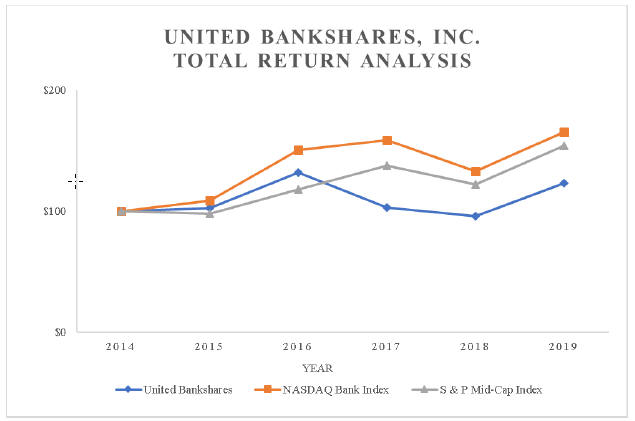in the income statement when the awards vest or are settled. The requirement to report those income tax effects in earnings
was applied to settlements occurring on or after January 1, 2017 and the impact of applying that guidance reduced reporting income tax expense by $
1,048,000
for the year of 2017. ASU No.
2016-09
also allows an employer to repurchase more of an employee’s shares than it could previously for tax withholding purposes without triggering liability accounting and make a policy election to account for forfeitures as they occur. The Company will continue to estimate the number of awards expected to be forfeited and adjust the estimate when it is no longer probable that the employee will fulfill the service condition, as was previously required. ASU No.
2016-09
also requires that all income
tax-related
cash flows resulting from share-based payments be reported as operating activities in the statement of cash flows. Previously, income tax benefits at settlement of an award were reported as a reduction to operating cash flows and an increase to financing cash flows to the extent that those benefits exceeded the income tax benefits reported in earnings during the award’s vesting period. The adoption of ASU No.
2016-09
did not have a material impact on the Company’s financial condition or results of operations.
In February 2016, the FASB issued ASU No.
2016-02,
“Leases (Topic 842)”. ASU No.
2016-02
includes a lessee accounting model that recognizes two types of leases, finance leases and operating leases, while lessor accounting will remain largely unchanged from the current GAAP. ASU No.
2016-02
requires, amongst other things, that a lessee recognize on the balance sheet a
right-of-use
asset and a lease liability for leases with terms of more than twelve months. The recognition, measurement, and presentation of expenses and cash flows arising from a lease by a lessee will depend on its classification as a finance or operating lease. In July 2018, the FASB issued ASU No.
2018-11
“Leases (Topic 842), Targeted Improvements.” This update creates an additional transition method, and a lessor practical expedient to not separate lease and
non-lease
components if specified criteria are met. The new transition method allows companies to use the effective date of the new leases standard as the date of initial application transition. Companies that elect this transition option will not adjust their comparative period financial information for the effect of ASC Topic 842, nor will they make the new required lease disclosure for periods before the effective date. In addition, these companies will carry forward their ASC Topic 840 disclosures for comparative periods. The practical expedient permits lessors to make an accounting policy election by class of underlying asset to not separate lease and
non-lease
components if specified criteria are met. In July 2018, the FASB issued ASU No.
2018-10
“Codification Improvements to ASC Topic 842, Leases.” This update includes narrow amendments to clarify how to apply certain aspects of the new leases standard. The amendments address the rate implicit in the lease, impairment of the net investment in the lease, lessee reassessment of lease classification, lessor reassessment of lease term and purchase options, variable payments that depend on an index or rate and certain transition adjustments. ASU
2018-10
does not make any substantive changes to the core provisions or principals of the new leases standard. United adopted the standard using the modified retrospective transition method on January 1, 2019. The Company has evaluated and has elected the practical expedients, which allows for existing leases to be accounted for consistent with current guidance, with the exception of the balance sheet recognition for lessees. Adoption of the standard resulted in the recognition of additional net lease assets and lease liabilities of $67,040,000 and $70,692,000, respectively, as of January 1, 2019. Of the difference between these two amounts, $1,049,000 was recorded as an adjustment to retained earnings.
In January 2016, the FASB issued ASU No.
2016-01,
“Financial Instruments Overall: Recognition and Measurement of Financial Assets and Financial Liabilities.” ASU
2016-01
makes changes to the classification and measurement of investments in equity securities, the presentation of certain fair value changes for financial liabilities measured at fair value under the fair value option and disclosure of fair value of instruments. In addition, ASU No.
2016-01
clarifies guidance related to the valuation allowance assessment when recognizing deferred tax assets resulting from unrealized losses on
available-for-sale
debt securities. ASU No.
2016-01
was adopted by United on January 1, 2018 and did not have a significant impact on the Company’s financial condition or results of operations.
In May 2014, the FASB issued ASU No.
2014-09,
“Revenue from Contracts with Customers (Topic 606).” ASU No.
2014-09
supersedes the revenue recognition requirements in ASC Topic 605, “Revenue Recognition”, and most industry-specific guidance throughout the ASC. The amendments require an entity to recognize revenue upon the transfer of promised goods or services to customers in an amount that reflects the consideration to which the entity expects to be entitled in exchange for those goods and services. The new revenue recognition standard sets forth a five-step principle-based approach for determining revenue recognition. For United, revenue is comprised of net interest income and noninterest income. As the standard does not apply to revenue associated with financial instruments, net interest income, gains and losses from securities, income from bank-owned life insurance (BOLI) and income from mortgage banking activities are not impacted by the standard. Based on a review and evaluation of a number of revenue contracts, United’s management determined that ASU No.
2014-09
impacts certain recurring revenue streams related to noninterest income such as fees from trust and brokerage services. However, based on an assessment of these revenue streams under the standard, management concluded
